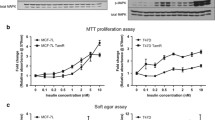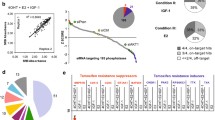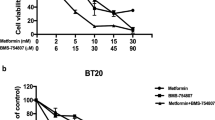Abstract
Earlier studies in our laboratory demonstrated that the steroidal antiestrogen ICI 182,780 is very effective in abolishing the tamoxifen‐resistant proliferation of MCF 7/5‐23 cells [1]. In addition, preliminary binding studies showed that ICI 182,780 increased the binding of insulin‐like growth factor (IGF)‐I to the MCF 7/5‐23 cells, although this finding was not the result of an increase in the expression of the insulin‐like growth factor‐I receptor (IGF‐IR). Hence, we reasoned that the inhibition of tamoxifen‐resistant cell growth by ICI 182,780 might have been due to increased expression of insulin‐like growth factor binding proteins (IGFBPs).
We observed the up‐regulation of non‐insulin‐suppressible IGF‐I binding in both the tamoxifen‐sensitive MCF 7/5‐21 cell line (1.5‐fold) and the tamoxifen‐resistant MCF 7/5‐23 cell line (2.5‐fold) after 5 days of treatment with ICI 182,780 (10−7 M) in serum‐free medium, suggesting a role for cell‐associated IGFBPs. Affinity cross‐linking experiments confirmed the presence of an IGF‐I:IGFBP complex of approximately 38‐kDa in tamoxifen or ICI 182,780‐treated cells. Western ligand blots showed higher levels of a soluble 30‐kDa IGFBP in media conditioned by either of the subclones that had been treated with ICI 182,780, an effect consistently opposed by estrogen (E2:10−9 M). RT‐PCR showed higher levels of IGFBP‐5 mRNA than any of the other known IGFBPs, suggesting that this was the major IGFBP subtype. The protein was subsequently identified by Western immunoblotting as IGFBP‐5. In conclusion, we postulate that this may be a mechanism contributing to the greater potency of ICI 182,780 in the growth inhibition of the MCF 7/5‐23, tamoxifen‐resistant cell line.
Similar content being viewed by others
References
Hu XF, Veroni M, DeLuise M, Wakeling A, Sutherland R, Watts CK, Zalcberg JR: Circumvention of tamoxifen resistance by the pure anti-estrogen ICI 182.780. Int J Cancer 55: 873-876, 1993
Vignon F, Bouton MM, Rochefort H: Antiestrogens inhibit the mitogenic effect of growth factors on breast cancer cells in the total absence of estrogens. Biochem Biophys Res Commun 146: 1502-1508, 1987
Knabbe C, Lippman ME, Wakefield LM, Flanders KC, Kasid A, Derynck R, Dickson RB: Evidence that transforming growth factor-ß is a hormonally regulated negative growth factor in human breast cancer cells. Cell 48: 417-428, 1987
Winston R, Kao P, Kiang D: Regulation of insulin-like growth factors by antiestrogen. Breast Cancer Res Treat 31: 107-115, 1994
Stewart AJ, Johnson MD, May FE, Westley BR: Role of insulin-like growth factors and the type I insulin-like growth factor receptor in the estrogen-stimulated proliferation of human breast cancer cells. J Biol Chem 265: 21172-82117, 1990
Thorsen T, Lahooti H, Rasmussen M, Aakvaag A: Oestradiol treatment increases the sensitivity of MCF-7 cells for the growth stimulatory effect of IGF-I. J Steroid Biochem Mol Biol 41: 537-540, 1992
Steele-Perkins G, Turner J, Edman JC, Hari J, Pierce SB, Stover C, Rutter WJ, Roth RA: Expression and characterization of a functional human insulin-like growth factor I receptor. J Biol Chem 263: 11486-11492, 1988
Nissley P, Lopaczynski W: Insulin-like growth factor receptors. Growth Factors 5: 29-43, 1991
Bach LA, Rechler MM: Insulin-like growth factor binding proteins. Diabetes Rev 5: 38-61, 1995
Clemmons DR, Camacho-Hubner C, Coronado F, Osborne CK: Insulin-like growth factor binding protein secretion by breast carcinoma cell lines: correlation with estrogen receptor status. Endocrinology 127: 2679-2686, 1990
Jones JI, Clemmons DR: Insulin-like growth factors and their binding proteins: biological actions. Endocr Rev 16: 3-34, 1995
Collett-Solberg PE, Cohen P: The role of the insulin-like growth factor binding proteins and the IGFBP proteases in modulating IGF action. Endocrinol Metab Clin North Am 25: 591-614, 1996
Elgin R, Busby WH Jr, Clemmons D: An insulin-like growth factor (IGF) binding protein enhances the biologic response to IGF-I. Proc Natl Acad Sci USA 84: 3254-3258, 1987
De Mellow JS, Baxter RC: Growth hormone-dependent insulin-like growth factor (IGF) binding protein both inhibits and potentiates IGF-I-stimulated DNA synthesis in human skin fibroblasts. Biochem Biophys Res Commun 156: 199-204, 1988
Jones JI, Gockerman A, Busby WH Jr, Camacho-Hubner C, Clemmons DR: Extracellular matrix contains insulin-like growth factor binding protein-5: potentiation of the effects of IGF-I. J Cell Biol 121: 679-687, 1993
Conover C: Potentiation of insulin-like growth factor (IGF) action by IGF-binding protein-3: studies of underlying mechanism. Endocrinology 130: 3191-3199, 1992
Andress D, Birnbaum R: Human osteoblast-derived insulin-like growth factor (IGF) binding protein-5 stimulates osteoblast mitogenesis and potentiates IGF action. J Biol Chem 267: 22467-22472, 1992
Mohan S, Nakao Y, Honda Y, Landale E, Leser U, Dony C, Lang K, Baylink D: Studies on the mechanisms by which insulin-like growth factor (IGF) binding protein-4 (IGFBP-4) and IGFBP-5 modulate IGF actions in bone cells. J Biol Chem 270: 20424-20431, 1995
Freiss C, Rochefort H, Vignon F: Mechanisms of 4-hydroxytamoxifen anti-growth factor activity in breast cancer cells: alterations of growth factor receptor binding sites and tyrosine kinase activity. Biochem Biophys Res Commun 173: 919-926, 1990
Huynh H, Nickerson T, Pollak MN, Yang XE: Regulation of insulin-like growth factor I receptor expression by the pure antiestrogen ICI 182780. Clin Cancer Res 2: 2037-2042, 1996
Pratt SE, Pollak MN: Estrogen and antiestrogen modulation of MCF7 human breast cancer cell proliferation is associated with specific alterations in accumulation of insulin-like growth factor-binding proteins in conditioned media. Cancer Res 53: 5193-5198, 1993
Huynh H, Yang XE, Pollak MN: Estradiol and antiestrogens regulate a growth inhibitory insulin-like growth factor binding protein 3 autocrine loop in human breast cancer cells. J Biol Chem 271: 1016-1021, 1996
Huynh H, Yang XE, Pollak MN: A role for insulin-like growth factor binding protein 5 in the antiproliferative action of the antiestrogen ICI 182780. Cell Growth Differ 7: 1501-1506, 1996
Musgrove FA, Sutherland RL: Acute effects of growth factors on T-47D breast cancer cell cycle progression. Eur J Cancer 29A: 2273-2279, 1993
Darbre PD, Yates J, Curtis S, King RJ: Effect of estradiol on human breast cancer cells in culture. Cancer Res 43: 349-354, 1983
Cullen KJ, Yee D, Sly WS, Perdue J, Hampton B, Lippman ME, Rosen N: Insulin-like growth factor receptor expression and function in human breast cancer. Cancer Res 50: 48-53, 1990
Kelley KM, Oh Y, Gargosky SE, Gucev Z, Matsumoto T, Hwa V, Ng L, Simpson DM, Rosenfeld RG: Insulin-like growth factor-binding proteins (IGFBPs) and their regulatory dynamics. Int J Biochem Cell Biol 28: 619-637, 1996
Lowry OH, Rosebrough NJ, Farr AL, Randall RJ: Protein measurement with the folin phenol reagent. J Biol Chem 193: 265-276, 1951
Bach LA, Leeding KS, Leng SL: Regulation of IGF-binding protein-6 by dexamethasone and ICFs in PC12 rat phaeochromocytoma cells. J Endocrinol 155: 225-232, 1997
Parisot JP, Hu XF, DeLuise M, Zalcberg JR: Altered expression of the IGF-I receptor in a tamoxifen-resistant human breast cancer cell line. Br J Cancer 79: 693-700, 1999
Olney RC, Tsuchiya K, Wilson DM, Mohtai M, Maloney WJ, Schurman DJ, Smith RL: Chondrocytes from osteoarthritic cartilage have increased expression of insulin-like growth factor I (IGF-I) and IGF-binding protein-3 (IGFBP-3) and-5, but not IGFBP-2 or IGFBP-4. J Clin Endocrinol Metabol 81: 1096-1103, 1996
Voutilainen R, Franks S, Mason HD, Martikainen H: Expression of insulin-like growth factor (IGF), IGF-binding protein, and IGF receptor messenger ribonucleic acids in normal and polycystic ovaries. J Clin Endocrinol Metabol 81: 1003-1008, 1996
Futscher B, Blake L, Gerlach J, Grogan T, Dalton W: Quantitative polymerase chain reaction analysis of mdrl mRNA in multiple myeloma cell lines and clinical specimens. Anal Biochem 213: 414-421, 1993
Wakeling AE, Dukes M, Bowler J: A potent specific pure antiestrogen with clinical potential. Cancer Res 51: 3867-3873, 1991
Fawell SE, White R, Hoare S, Sydenham M, Page M, Parker MG: Inhibition of estrogen receptor-DNA binding by the ‘pure’ antiestrogen ICI 164,384 appears to be mediated by impaired receptor dimerization. Proc Natl Acad Sci USA 87: 6883-6887, 1990
Dauvois S, Danielian PS, White R, Parker MG: Antiestrogen ICI 164,384 reduces cellular estrogen receptor content by increasing its turnover. Proc Natl Acad Sci USA 89: 4037-4041, 1992
Parisot JP, Hu XE, Sutherland RL, Wakeling A, Zalcberg JR, DeLuise M: The pure antiestrogen ICI 182,780 binds to a high-affinity site distinct from the estrogen receptor. Int Cancer 62: 480-484, 1995
Oh Y, Muller HL, Pham H, Rosenfeld RC: Demonstration of receptors for insulin-like growth factor binding protein-3 on Hs578T human breast cancer cells. J Biol Chem 268: 26045-26048, 1993
Karas M, Danilenko M, Fishman D, LeRoith D, Levy J, Sharoni Y: Membrane-associated insulin-like growth factor-binding protein-3 inhibits insulin-like growth factor-I-induced insulin-like growth factor-I receptor signaling in ishikawa endometrial cancer cells. J Biol Chem 272: 16514-16520, 1997
Shimasaki S, Shimonaka M, Zhang HP, Ling N: Identification of five different insulin-like growth factor binding proteins (IGFBPs) from adult rat serum and molecular cloning of a novel IGFBP-5 in rat and human. J Biol Chem 266: 10646-10653, 1991
McGuire SE, Hilsenbeck SC, Figueroa JA, Jackson JG, Yee D: Detection of insulin-like growth factor binding proteins (IGF-BPs) by ligand blotting in breast cancer tissues. Cancer Lett 77: 25-32, 1994
Grimes RW, Manni A, Hammond JM: Postsynthetic regulation of insulin-like growth factor-binding protein-3 by MCF-7 human breast cancer cells in culture. Breast Cancer Res Treat 39: 187-196, 1996
Adamo ML, Shao ZM, Lanau F, Chen JC, Clemmons DR, Roberts Jr. CT, LeRoith D, Fontana JA: Insulin-like growth factor-I (IGF-I) and retinoic acid modulation of IGF-binding proteins (IGFBPs): IGFBP-2,-3, and-4 gene expression and protein secretion in a breast cancer cell line. Endocrinology 131: 1858-1866, 1992
Rozen F, Yang XF, Huynh H, Pollak M: Antiproliferative action of vitamin D-related compounds and insulin-like growth factor-binding protein 5 accumulation. J Natl Cancer Inst 89: 652-656, 1997
Hwa V, Oh Y, Rosenfeld R: Insulin-like growth factor binding protein-3 and-5 are regulated by transforming growth factor-beta and retinoic acid in the human prostate adenocarcinoma cell line PC-3. Endocrine 6: 235-242, 1997
Tonner E, Barber M, Travers M, Logan A, Flint D: Hormonal control of insulinlike growth factor-binding protein-5 production in the involuting mammary gland of the rat. Endocrinology 138: 5101-5107, 1997
Author information
Authors and Affiliations
Rights and permissions
About this article
Cite this article
Parisot, J.P., Leeding, K.S., Hu, X.F. et al. Induction of insulin‐like growth factor binding protein expression by ICI 182,780 in a tamoxifen‐resistant human breast cancer cell line. Breast Cancer Res Treat 55, 231–242 (1999). https://doi.org/10.1023/A:1006274712664
Issue Date:
DOI: https://doi.org/10.1023/A:1006274712664




